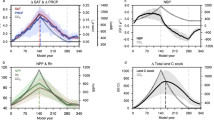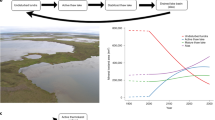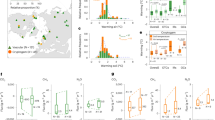Abstract
Global methane emissions from natural wetlands and carbon release from permafrost thaw have a positive feedback on climate, yet are not represented in most state-of-the-art climate models. Furthermore, a fraction of the thawed permafrost carbon is released as methane, enhancing the combined feedback strength. We present simulations with an inverted intermediate complexity climate model, which follows prescribed global warming pathways to stabilization at 1.5 or 2.0 °C above pre-industrial levels by the year 2100, and which incorporates a state-of-the-art global land surface model with updated descriptions of wetland and permafrost carbon release. We demonstrate that the climate feedbacks from those two processes are substantial. Specifically, permissible anthropogenic fossil fuel CO2 emission budgets are reduced by 9–15% (25–38 GtC) for stabilization at 1.5 °C, and 6–10% (33–52 GtC) for 2.0 °C stabilization. In our simulations these feedback processes respond more quickly at temperatures below 1.5 °C, and the differences between the 1.5 and 2 °C targets are disproportionately small. This key finding holds for transient emission pathways to 2100 and does not account for longer-term implications of these feedback processes. We conclude that natural feedback processes from wetlands and permafrost must be considered in assessments of transient emission pathways to limit global warming.
This is a preview of subscription content, access via your institution
Access options
Access Nature and 54 other Nature Portfolio journals
Get Nature+, our best-value online-access subscription
$29.99 / 30 days
cancel any time
Subscribe to this journal
Receive 12 print issues and online access
$259.00 per year
only $21.58 per issue
Buy this article
- Purchase on Springer Link
- Instant access to full article PDF
Prices may be subject to local taxes which are calculated during checkout



Similar content being viewed by others
Change history
15 October 2018
In the version of this Article originally published, a parallelization coding problem, which meant that a subset of model grid cells were subjected to erroneous updating of atmospheric gas concentrations, resulted in incorrect calculation of atmospheric CO2 for these grid cells, and therefore underestimation of the carbon uptake by land through vegetation growth and eventual increases to soil carbon stocks. Having re-run the simulations using the corrected code, the authors found that the original estimates of the impact of the natural wetland methane feedback were overestimated. The permafrost and natural wetland methane feedback requires lower permissible emissions of 9–15% to achieve climate stabilization at 1.5 °C, compared with the original published estimate of 17–23%. The Article text, Table 1 and Fig. 3 have been updated online to reflect the revised numerical estimates. The Supplementary Information file has also been amended, with Supplementary Figs 6, 7, 8 and 9 replaced with revised versions produced using the corrected model output. As the strength of feedbacks remain significant, still require inclusion in climate policy and are nonlinear with global warming, the overall conclusions of the Article remain unchanged.
References
Copenhagen Accord FCCC/CP/2015/L.9/Rev.1 (UNFCCC, 2009).
Adoption of the Paris Agreement FCCC/CP/2015/L.9/Rev.1 (UNFCCC, 2015).
Huntingford, C. et al. The link between a global 2 °C warming threshold and emissions in years 2020, 2050 and beyond. Environ. Res. Lett. 7, 014039 (2012).
Rogelj, J., McCollum, D. L., Reisinger, A., Meinshausen, M. & Riahi, K. Probabilistic cost estimates for climate change mitigation. Nature 493, 79–83 (2013).
Huntingford, C. & Mercado, L. M. High chance that current atmospheric greenhouse concentrations commit to warmings greater than 1.5°C over land. Sci. Rep. 6, 30294 (2016).
IPCC Climate Change 2013: The Physical Science Basis (eds Stocker, T. F. et al.) (Cambridge Univ. Press, 2013).
Cox, P. M., Betts, R. A., Jones, C. D., Spall, S. A. & Totterdell, I. J. Acceleration of global warming due to carbon-cycle feedbacks in a coupled climate model. Nature 408, 184–187 (2000).
Gedney, N., Cox, P. M. & Huntingford, C. Climate feedback from wetland methane emissions. Geophys. Res. Lett. 31, L20503 (2004).
Shindell, D. T., Walter, B. P. & Faluvegi, G. Impacts of climate change on methane emissions from wetlands. Geophys. Res. Lett. 31, L21202 (2004).
Burke, E. J. et al. Quantifying uncertainties of permafrost carbon–climate feedbacks. Biogeosciences 14, 3051 (2017).
McGuire, A. D. et al. Variability in the sensitivity among model simulations of permafrost and carbon dynamics in the permafrost region between 1960 and 2009. Glob. Biogeochem. Cycles 30, 1015–1037 (2016).
Burke, E. J., Chadburn, S. E., Huntingford, C. & Jones, C. D. CO2 loss by permafrost thawing implies additional emissions reductions to limit warming to 1.5 or 2 °C. Environ. Res. Lett. 13, 024024 (2018).
Millar, R. J. et al. Emission budgets and pathways consistent with limiting warming to 1.5 °C. Nat. Geosci. 10, 741–747 (2017).
Tokarska, K. B. & Gillett, N. P. Cumulative carbon emissions budgets consistent with 1.5 °C global warming. Nat. Clim. Change 8, 296–299 (2018).
Taylor, K. E., Stouffer, R. J. & Meehl, G. A. An overview of CMIP5 and the experiment design. Bull. Am. Meteorol. Soc. 93, 485–498 (2012).
Schädel, C. et al. Potential carbon emissions dominated by carbon dioxide from thawed permafrost soils. Nat. Clim. Change 6, 950 (2016).
Schuur, E. A. G. et al. Climate change and the permafrost carbon feedback. Nature 520, 171–179 (2015).
Crill, P. M. & Thornton, B. F. Whither methane in the IPCC process? Nat. Clim. Change 7, 678 (2017).
Huntingford, C. et al. Flexible parameter-sparse global temperature time profiles that stabilise at 1.5 and 2.0 °C. Earth Syst. Dynam. 8, 617–626 (2017).
Best, M. et al. The Joint UK Land Environment Simulator (JULES), model description–Part 1: energy and water fluxes. Geosci. Model Dev. 4, 677–699 (2011).
Clark, D. et al. The Joint UK Land Environment Simulator (JULES), model description–Part 2: carbon fluxes and vegetation dynamics. Geosci. Model Dev. 4, 701–722 (2011).
Huntingford, C. & Cox, P. M. An analogue model to derive additional climate change scenarios from existing GCM simulations. Clim. Dynam. 16, 575–586 (2000).
Huntingford, C. et al. IMOGEN: an intermediate complexity model to evaluate terrestrial impacts of a changing climate. Geosci. Model Dev. 3, 679–687 (2010).
Chadburn, S. et al. An improved representation of physical permafrost dynamics in the JULES land-surface model. Geosci. Model Dev. 8, 1493–1508 (2015).
Burke, E. J., Chadburn, S. E. & Ekici, A. A vertical representation of soil carbon in the JULES land surface scheme (vn4. 3_permafrost) with a focus on permafrost regions. Geosci. Model Dev. 10, 959–975 (2017).
Morice, C. P., Kennedy, J. J., Rayner, N. A. & Jones, P. D. Quantifying uncertainties in global and regional temperature change using an ensemble of observational estimates: the HadCRUT4 data set. J. Geophys. Res. 117, D08101 (2012).
Meinshausen, M. et al. The RCP greenhouse gas concentrations and their extensions from 1765 to 2300. Clim. Change 109, 213 (2011).
van Vuuren, D. P. et al. Energy, land-use and greenhouse gas emissions trajectories under a green growth paradigm. Glob. Environ. Change 42, 237–250 (2017).
Brown, J., Ferrians, O. Jr, Heginbottom, J. & Melnikov, E. Circum-Arctic Map of Permafrost and Ground-Ice Conditions (National Snow and Ice Data Center, 1998).
Chadburn, S. E. et al. An observation-based constraint on permafrost loss as a function of global warming. Nat. Clim. Change 7, 340–344 (2017).
Zhang, B. et al. Methane emissions from global wetlands: an assessment of the uncertainty associated with various wetland extent data sets. Atmos. Environ. 165, 310–321 (2017).
Poulter, B. et al. Global wetland contribution to 2000–2012 atmospheric methane growth rate dynamics. Environ. Res. Lett. 12, 094013 (2017).
Turetsky, M. R. et al. A synthesis of methane emissions from 71 northern, temperate, and subtropical wetlands. Glob. Change Biol. 20, 2183–2197 (2014).
Saunois, M. et al. The global methane budget 2000–2012. Earth Syst. Sci. Data 8, 697–751 (2016).
Jones, C. et al. The HadGEM2-ES implementation of CMIP5 centennial simulations. Geosci. Model Dev. 4, 543 (2011).
Zona, D. et al. Cold season emissions dominate the Arctic tundra methane budget. Proc. Natl Acad. Sci. USA 113, 40–45 (2016).
McNorton, J. et al. Role of regional wetland emissions in atmospheric methane variability. Geophys. Res. Lett. 43, 433–444 (2016).
Clark, D. et al. The Joint UK Land Environment Simulator (JULES), model description–Part 2: carbon fluxes and vegetation dynamics. Geosci. Model Dev. 4, 701–722 (2011).
Gedney, N. & Cox, P. M. The sensitivity of global climate model simulations to the representation of soil moisture heterogeneity. J. Hydrometeorol. 4, 1265–1275 (2003).
Marthews, T., Dadson, S., Lehner, B., Abele, S. & Gedney, N. High-resolution global topographic index values for use in large-scale hydrological modelling. Hydrol. Earth Syst. Sci. 19, 91–104 (2015).
Klein Goldewijk, K., Beusen, A., Van Drecht, G. & De Vos, M. The HYDE 3.1 spatially explicit database of human‐induced global land‐use change over the past 12,000 years. Glob. Ecol. Biogeogr. 20, 73–86 (2011).
Sitch, S., Cox, P. M., Collins, W. J. & Huntingford, C. Indirect radiative forcing of climate change through ozone effects on the land-carbon sink. Nature 448, 791–794 (2007).
Stohl, A. et al. Evaluating the climate and air quality impacts of short-lived pollutants. Atmos. Chem. Phys. 15, 10529–10566 (2015).
Etminan, M., Myhre, G., Highwood, E. J. & Shine, K. P. Radiative forcing of carbon dioxide, methane, and nitrous oxide: a significant revision of the methane radiative forcing. Geophys. Res. Lett. 43, 614–623 (2016).
IPCC Climate Change 2001: The Scientific Basis (eds Houghton, J. T. et al.) (Cambridge Univ. Press, 2001).
Acknowledgements
This work was undertaken as part of the UK Natural Environment Research Council’s programme ‘Understanding the Pathways to and Impacts of a 1.5 °C Rise in Global Temperature’ through grants NE/P015050/1 CLIFFTOP (to E.C.-P., G.H. and S.E.C.), NE/P014909/1, MOC1.5 (to W.J.C., C.P.W., C.H., P.M.C. and S.S.) and NE/P014941/1 CLUES (to A.B.H., P.M.C. and T.P.). The authors also acknowledge support for E.J.B. and N.G. through the Joint UK BEIS/Defra Met Office Hadley Centre Climate Programme (GA01101), E.J.B. through CRESCENDO (EU project 641816), A.B.H. through an EPSRC Fellowship ‘Negative Emissions and the Food–Energy–Water Nexus’ (EP/N030141/1), and C.H. through CEH National Capability Funding. The authors also acknowledge the wetland extent data products provided by B. Zhang of Auburn University and B. Poulter of the NASA Goddard Space Flight Center.
Author information
Authors and Affiliations
Contributions
G.H., E.J.B., S.E.C. and E.C.-P. conceived and developed the project. E.C.-P. and C.H. led the development of the inverse IMOGEN model system. E.J.B. and S.E.C. contributed code and expertise on permafrost and soil carbon modelling. N.G., S.E.C. and E.C.-P. contributed code and expertise on the JULES wetlands methane scheme. A.B.H. and T.P. contributed land-use change data, W.J.C. and C.P.W. ozone ancillary data and S.S. contributed expertise on the ozone damage effects, respectively. E.C.-P., C.H., G.H., E.J.B., S.E.C., W.J.C., C.P.W., P.M.C., A.B.H. and T.P. contributed to the design of the IMOGEN model runs. All authors contributed to the interpretation of the results and to the writing of the paper.
Corresponding author
Ethics declarations
Competing interests
The authors declare no competing interests.
Additional information
Publisher’s note: Springer Nature remains neutral with regard to jurisdictional claims in published maps and institutional affiliations.
Supplementary information
Supplementary Information
Supplementary Figures and Tables
Rights and permissions
About this article
Cite this article
Comyn-Platt, E., Hayman, G., Huntingford, C. et al. Carbon budgets for 1.5 and 2 °C targets lowered by natural wetland and permafrost feedbacks. Nature Geosci 11, 568–573 (2018). https://doi.org/10.1038/s41561-018-0174-9
Received:
Accepted:
Published:
Issue Date:
DOI: https://doi.org/10.1038/s41561-018-0174-9
This article is cited by
-
Sensitivity of Arctic CH4 emissions to landscape wetness diminished by atmospheric feedbacks
Nature Climate Change (2023)
-
Weakening greenhouse gas sink of pristine wetlands under warming
Nature Climate Change (2023)
-
Decadal Changes in Atmospheric Methane Emissions in the Eastern Himalayan Region: Source Apportionment and Impact Assessment
International Journal of Environmental Research (2023)
-
Impact of interannual and multidecadal trends on methane-climate feedbacks and sensitivity
Nature Communications (2022)
-
Possibility for strong northern hemisphere high-latitude cooling under negative emissions
Nature Communications (2022)



